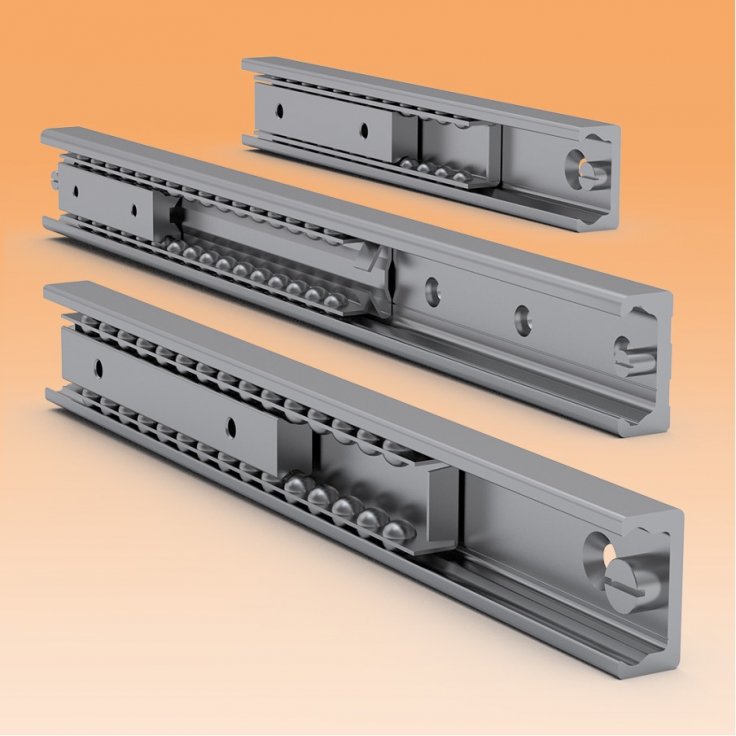
Telescopic slides are versatile and make a difference in industry, furniture and many other sectors. However, there are a few things to bear in mind when choosing the right slide, so that they can develop their full potential.
In our partner's range of industrial slide manufacturers, you'll find the right solution for almost any application.
What exactly is the difference between a telescopic rail and a linear guide?
The term telescopic rail means exactly what it says. The moving part of the rail can be extended telescopically along its entire length. Depending on the type of extension, the moving part can be extended not only to the actual length of the rail, but also beyond in the case of telescopic rails with over-extension.
If a telescopic rail is to be installed, you first need to decide how far the drawer or what is being removed needs to be extendable.
How far can the telescopic rail be extended?
The decision as to how far the telescopic rail can be extended depends entirely on the accessibility of the drawer or the item to be removed at the end.
Partial extension
When the rail is partially withdrawn, approximately ⅔ of the drawer remains "stuck" in the cupboard or body. Such a sliding system is suitable when access to the entire item to be extracted is not required, or even when there isn't much space to extract the drawer.
Super extension
The mobile element can be completely removed when fully extended. The entire contents of the drawer or rack are easily accessible.
Full extension
There are also applications where full extension is not enough. For example, if an element is placed directly above the pull-out, or if the body itself protrudes slightly. You won't be able to reach the entire drawer, even when it's fully extended. This is where telescopic rails with full extension come in. They can be extended slightly beyond the actual length of the telescopic rail.
Permissible loads
Load capacity depends on: - evolution: increasing it limits the admissible load, while reducing it increases performance.
Flush installation is not recommended and implies considerably reduced admissible loads, or even minimum loads for certain models.
What do the different types of extension mean for rail weight?
A maximum allowable load is supported on each skid. Although calculated with a large safety margin, the load must be adjusted according to the intended use and type of assembly. Intensive use therefore requires a reduction in the maximum load supported. Technical data sheets are available on our partner's website.
What are the typical areas of application for the different food variants?
Cushioned rails are generally found in applications where the inside of the drawer needs to be protected against impact when the drawer is retracted (e.g. in medical environments).
Self-closing telescopic rails, on the other hand, are used in smaller applications, as the space-saving spring mechanism can be installed in particularly short rails without additional shock absorbers. After all, extra power also requires space.
Sounds complicated?
But it's actually quite simple. To ensure that a telescopic rail can be easily retracted and removed, and that it can also carry a lot of weight, the number of ball bearings and the length of the rail are crucial. If more ball bearings are installed, the rail is stronger.
If slow, silent closing is not required, less expensive self-closing rails can easily be used as a basic solution.
Conclusion
The use of telescopic slides offers an efficient and versatile solution for many applications, in both the industrial and domestic fields. Their ingenious design allows easy access to stored items, while maximizing available space. These devices offer enhanced stability and durability, improving the safety and practicality of drawers, trays and other structures into which they are integrated.
Telescopic slides are particularly appreciated for their ability to support heavy loads while ensuring smooth movement. Their adaptability to a variety of configurations and the possibility of integrating them into tight spaces make them an ideal choice for optimizing the organization and functionality of furniture, electronic equipment and other devices.
What's more, the use of quality materials and innovative technologies in the manufacture of telescopic slides contributes to their longevity and resistance to wear and tear. This translates into an enhanced user experience and lower long-term maintenance costs.
In summary, telescopic slides represent a reliable and effective solution to mobility and access needs in a variety of applications. Their judicious adoption can not only enhance product functionality but also contribute to more efficient use of space and a better user experience.









